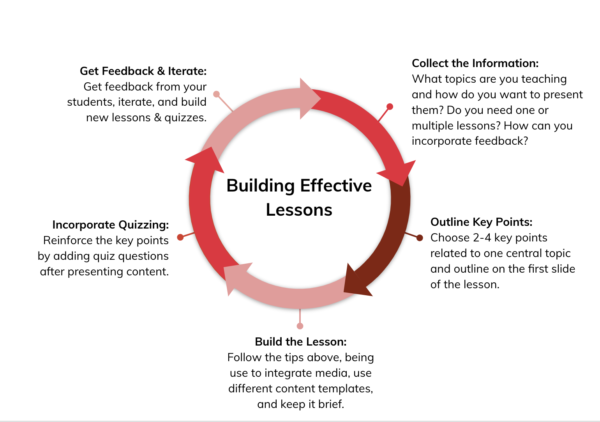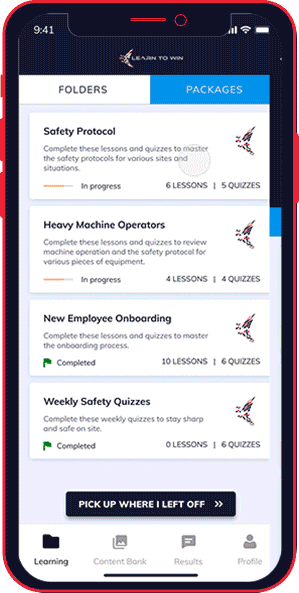The way you present information to learners impacts how well they will engage with and understand that information. Teachers are responsibility for presenting new information in clear and concise manner to help their learners get the most out of the content.
In this blog post, we’ll cover some strategies for building lessons and quizzes that effectively teach your team.
First, what’s the difference between lessons and quizzes?
Lessons are intended to teach and reinforce information. Learners can take lessons as many times as they would like, at their own pace. Teachers should emphasize completion over accuracy for any activities or questions integrated into lessons.
Quizzes are meant to test a learner’s knowledge and understanding of material learned in lessons. Teachers use quizzes to identify team strengths and knowledge gaps so they know where to spend more time. Quizzes can also be used as motivation to help team members show what they know and perform at their best.
Next, let’s dive into how to build the most effective lessons and quizzes. Feel free to take notes…

How Do I Build Effective Lessons?
- Mix it up – Don’t just send learners a long wall of text! Mix up paragraphs of text with pictures, videos, and diagrams. Use a variety of content templates, and encourage your learners to interact with the lessons as much as possible. Interesting lessons will keep learners engaged and focused.
- Keep it short & sweet – After 5-7 minutes, your learners will naturally begin to lose focus, struggling to retain all of the information. Create more shorter lessons than fewer longer ones. And if you’re not convinced, read this blog post about microlearning to learn how education research can help improve your organization’s teaching strategies.
- Quiz, quiz, quiz – Don’t limit questions to just quizzes or tests. We recommend adding one quiz question per every one to two content slides. You should constantly encourage your learners to engage with new material, especially in a low-stakes environment to start.
- Tailor your lessons to specific user groups – Instead of just broadly teaching a concept to the whole group tailor lessons to groups of people to teach them exactly what they need to know. Learn to Win’s user group functionality helps you send the right material to the right people.
How Do I Build Effective Quizzes?
- Mix it up – Use a variety of question types, such as multiple choice, free response, and true/false. Using media in the question, like integrating an image or video, also keeps learners engaged with the material.
- Quiz for the analytics you’re looking for – Figure out what you, as the teacher, want to know that your learners know. Do you want to make sure your employee understands the difference protocols? Do you want to check that your team knows what fronts to expect on Saturday? Ask the right questions and get rid of the fluff to find the information you’re looking for.
- Use free response questions – Free response questions inform you not just if your learners know the material, but also their thought processes. If you want to make sure your learners not only know the correct answer, but why it’s the correct answer, use free response to see exactly what they are thinking.
Let’s Put These Strategies Into Practice…
How do you take unstructured content from a PDF or slide deck and turn it into an easily digestible lesson? This diagram shows the steps to create an effective lesson:

Let’s look at an example lesson that follows these principles:
Step 1: Collect the Information. For this lesson, we collected the PDF training manual and all of the media we wanted to incorporate in the lesson.
Step 2: Outline Key Points. Then, on the first slide, we wrote a lesson summary that outlined the 3 key points we wanted learners to take away from this lesson.
Step 3: Build the Lesson. Next, we started explaining each of the 3 key points on 1-2 slides each, incorporating images to keep it engaging for our learners.
Step 4: Incorporate Quizzing. For each key point, we added 1-2 questions to reinforce understanding. Within a lesson, the goal is not to test understanding, but rather to help learners reinforce information in a low-stakes environment. Then, we repeated steps 3 and 4 for each of the key points.

Step 5: Get Feedback & Iterate. At the end of the lesson, we asked our learners what they liked and didn’t like about the lesson. You might ask about the lesson structure, the overall curriculum design, or media integrations within the lesson.
What’s Next?
Learning is a dynamic process not limited to only students.
Becoming a better teacher involves learning, too! Teachers learn from their students by receiving feedback and getting insights into how they think. Teaching & learning processes always have room for improvement, through a constant cycle of implementation, feedback, and iteration.
How will you use these teaching strategies to help your team learn better?

